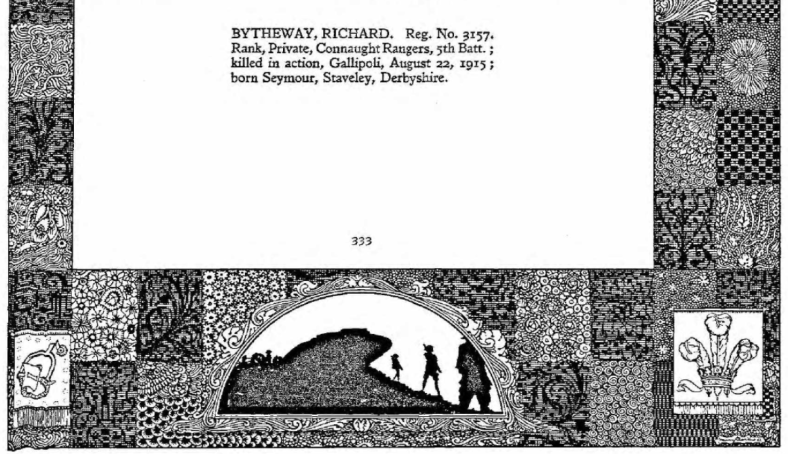Richard Bytheway, born in 1892, was a younger brother of my great grandmother, hence my great-great-uncle. He was the second youngest of 8 children, all born and brought up in a tiny, 3-roomed miner’s cottage tied to Seymour Colliery just outside Staveley in Derbyshire.
The 1911 census has him still living in the Seymour cottage but shortly after that he must have moved away because when he enlisted in the army in late August or early September 1914, no doubt responding to Kitchener’s famous appeal for volunteers, his residence was listed as Rotherham in Yorkshire.
He was duly enlisted as 14663 Private Bytheway of the York and Lancaster Regiment (known more colloquially as the Yorks and Lancs).
After basic training Richard’s battalion embarked not for France or Belgium but were assigned to what has commonly been labelled an infamous “sideshow” – they were bound for Gallipoli.
At the end of July 1915 the battalion arrived at Mudros on the island of Limnos, the common staging point for troops before crossing the final stretch of Aegean to Gallipoli itself.
It would seem that it was there that Richard Bytheway, with others, was transferred to the 5th Battalion Connaught Rangers who were under-strength. The war diary of the Connaughts records reinforcements joining on 4th August when they too were at Mudros and I am guessing Richard may well have been part of that contingent. Anyway, he definitely became 3157 Private Bytheway of the Connaught Rangers.

Connaught Rangers moving up into position
Two days later, on 6th August, the battalion embarked on HMS Clacton at 3am and sailed from Limnos to ANZAC Cove where they disembarked at 4pm that afternoon, taking positions in the aptly named Shrapnel Gully before moving up to the front line the following week.
Here, their introduction must have been horrific as they spent the next couple of days retrieving and burying corpses from Aghyl Dere Gully which was full of bodies after an earlier attack. Remember that this was in the middle of summer in Turkey where the heat was stifling and the stench must have been appalling.
A week of back-breaking trench improvement followed this before the Connaughts were assigned to support a major attack by the ANZACs on Hill 60, scheduled for 21st August. The Connaughts’ role was to attack the wells at Kabak Kuyu on the flank.

ANZAC Cove with Hill 60 on the horizon
On the evening of 20th August the battalion moved up to a position behind the 4th Battalion South Wales Borderers. They remained there until the afternoon of the following day when the attack was launched.
I will let the unusually effusive war dairy entries take over the story from there:

Transcript: “Kabak Kuyu 3.40pm: The first Company (C) dashed forward with a cheer through the gap and with great dash made for the well and trenches at Kabak Kuyu. They were followed by D Company, who followed close by and in successive lines at 4 paces distance and all cheering with fixed bayonets but no firing was allowed until the line was won. The two leading companie,s as soon as they had rushed the trenches, wheeled to the right and engaged the enemy along the Sunken Road and the Communication Trench. One platoon under 2nd Lt. G R Bennett bombed and blocked the Communication Trench and forced the Turks to leave this trench.
4.20pm: A Company was sent up in support and dashed forward to reinforce the left of the line. The reserve (B Coy) moved up the Sunken Road with two platoons and supported the right of the line and got up communication with the New Zealanders who had captured a trench on Hill 60.”

6.55pm: The O.C. 5th Bn the Connaught Rangers now began to consolidate the line won and when the 5th Ghurkhas came up on the left of the line night came on rapidly and as the sun went down the men of the Rangers began to dig and make their position capable of resisting any attack. A Platoon of the Rangers had been sent forward and were actually in the New Zealanders trenches and although losing their officer and many men remained there until relieved the next day (22nd Aug). The charge was most brilliantly and gallantly carried out and although the losses were severe (3 Officers killed, 9 wounded; Other Ranks killed 43, wounded 158, missing 47. Total 260; together with losses up to date, 15 killed and 119 wounded and 7 Officers = 401 casualties exclusive of sick) the Battalion held on gallantly throughout the night of the 21st-22nd August (strangely enough the anniversary of its formation) and the next evening were relieved with the exception of 1 Officer and 50 men and marched back to the bivouac of two nights ago behind the SWB entrenchments. They had done splendid work in digging saps to the New Zealand trenches and to the Well, and the position was secure when they left it.”
“Secure” it may well have been but at the cost of nearly half the battalion’s effective strength and one of those killed was Richard Bytheway.
His body was not recovered and his final resting place remains unknown so his name is just one of the 20,956 names on the Helles Memorial commemorating Commonwealth service personnel with no known grave.

Oddly, because he was serving in an Irish regiment when he was killed, Richard also appears in the memorial record created after the war to commemorate the “Irishmen who fell in the Great European War”:

